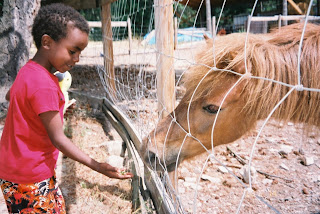Laolao and Laoye were waiting for us, and it was a happy reunion. We spent about an hour getting our rental car for the week (so we wouldn't have to drive the bus around everywhere). Then headed off for lunch, only to find that a big wind and thunderstorm had knocked power out in the area and businesses were closed. So we headed back to the airport and ate lunch there.
 After lunch we drove to our place of lodging - some good friends of Laolao and Laoye who have a lovely house on the lake. They're right by the lake, but given the steep hills around Okanagan Lake, it takes 83 steps to get from their yard to the shore. (And another 17 steps to get to their yard from the main living level!)
After lunch we drove to our place of lodging - some good friends of Laolao and Laoye who have a lovely house on the lake. They're right by the lake, but given the steep hills around Okanagan Lake, it takes 83 steps to get from their yard to the shore. (And another 17 steps to get to their yard from the main living level!) View from the road overlooking E&A's house and Okanagan Lake.
View from the road overlooking E&A's house and Okanagan Lake. We spent about five days in Kelowna. One day we headed out to an orchard - the region is famous for its fruit. We did a tour on a tractor-drawn wagon, learning about the different kinds of apples they grow, and other fruit like cherries and apricots. Most things were rather behind, owing to a cool spring, and hail had destroyed a good chunk of the cherry crop. But we enjoyed some cherries and apricots from the little orchard gift shop. They also had some petting goats and goat-enclosure, complete with walkway so the goats could get some exercise. As the goats were in the field, the kids enjoyed the goat walkway!
We spent about five days in Kelowna. One day we headed out to an orchard - the region is famous for its fruit. We did a tour on a tractor-drawn wagon, learning about the different kinds of apples they grow, and other fruit like cherries and apricots. Most things were rather behind, owing to a cool spring, and hail had destroyed a good chunk of the cherry crop. But we enjoyed some cherries and apricots from the little orchard gift shop. They also had some petting goats and goat-enclosure, complete with walkway so the goats could get some exercise. As the goats were in the field, the kids enjoyed the goat walkway!

This is the area that was affected by the huge fires in 2003. Twelve of the wooden tresles were destroyed and 2 steel ones were badly damaged. However, an effort was made to rebuild beginning in the fall of 2004, and by March of this year, all the trestles had been rebuilt and repaired. Many of the trestles we crossed were obviously new construction, but much of the forest had already undergone rejuvenation and new growth, though we could see burned trunks in large parts of the valley.
In the nearby town of Peachland, we visited a parrot rescue operation called Parrot Island (nothing islandish about it, but there you go). This is a sanctuary for abandoned and abused parrots and other exotic birds. Many parrots can live for 50, 60, 70 years and more, so it is a lifetime commitment to own a parrot. Especially as parrots mate for life. When you buy a parrot, you essentially become its mate - the other being it bonds to and looks to for companionship and affection. Your parrot doesn't understand when you disappear for a week or two's holidays. And it will get lonely if you're gone all day.
So the message of this organization is simple: don't buy parrots. Once a bird enters their doors, they do not sell it. They are committed to providing a home for the rest of its life. Currently they have about 80 parrots in the sanctuary, from across Canada (and even some brought from the States), taken in when the owners died or abandoned their birds as "too much work."












No comments:
Post a Comment